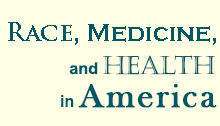Education
Higher Education Module
Race, Medicine, and Health in America
Class 6: Hurricane Katrina
Introduction
The sixth and final class delves into Hurricane Katrina in 2005, the worst environmental disaster in American history. An uneasy truth of Katrina is that the vulnerability and suffering highlighted by the disaster pivoted upon a much longer history of poor housing, marginalized populations, and vulnerability not just in the Gulf Coast, but throughout the United States. This class deals with the ways in which Hurricane Katrina reified important questions of public health and dependency upon life-sustaining medical technologies for survival. Although there is a wealth of books and articles on Hurricane Katrina, few deal with questions of medicine and health. In particular, disaster victims in need of life sustaining technologies like dialysis and asthma pumps were particularly vulnerable during and after the storm that knocked out electricity for weeks. Katrina’s Imprint edited by Keith Wailoohighlights what patients in hospitals located in New Orleans suffering from kidney failure dealt with during the storm. Laurie Abraham’s book, though not about Katrina, puts a sociological and recent historical framework on the vulnerability of technologically dependent patient populations. Resilience and Opportunity talks in part about building resiliency in health care post-Katrina.
Class Resources
Readings
Wailoo, Keith, et al. Katrina’s Imprint: Race and Vulnerability in America. New Brunswick, NJ: Rutgers University Press, 2010, pp. 34-45.
Abraham, Laurie Kaye. Mama Might Be Better off Dead: The Failure of Healthcare in Urban America. Chicago: University of Chicago Press, 1994.
Liu, Amy, Richard M. Mizelle, Jr., Alison Plyer, and Roland Anglin, Resilience and Opportunity: Lessons from the US Gulf Coast after Katrina and Rita. Washington, DC: Brookings Institution Press, 2012, 45-64).
Discussion Questions:
- Is there an evacuation plan in the town or city where you live? If so, what are the benefits and limitations of the plan?
- How was Hurricane Katrina exacerbated by special needs populations in the Gulf Coast, particularly those individuals dependent upon medical technology?
- What measures should hospitals and local health facilities implement in anticipation of future disasters?
- If another major hurricane hit the Gulf Coast this year are we better prepared to deal with the evacuation of a major American city compared to 2005?
- There were an untold number of victims that died or suffered as a result of diabetes, asthma, heart disease and other conditions. Yet, in many ways there was nothing new about Hurricane Katrina in terms of the long vulnerability of poor people in this country. How does Hurricane Katrina help us better understand the Banes family described by Laurie Abraham?


